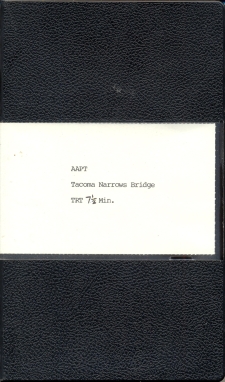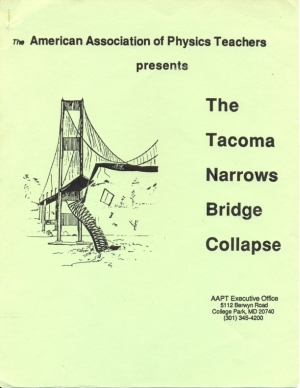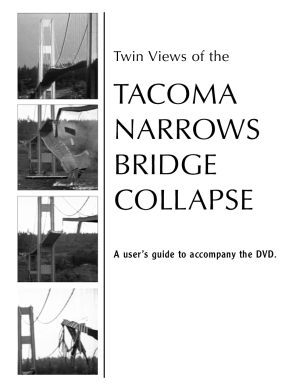
This videotape shows the collapse of the first Tacoma Narrows bridge, which occurred on the morning of November 7, 1940. It includes a brief history of the bridge’s construction and opening, and of the strange behavior that led to its collapse. Some of the narration, or at least the script, is by Leonard Coatsworth, a reporter for the Tacoma News-Tribune, who drove onto the bridge just before it collapsed, and wrote about his experience in the newspaper. Other parts of the narration contain statements by Professor F. B. Farquharson of the University of Washington, who was examining the behavior of the bridge and attempting to stop its oscillation, and by Ken Arkin, chairperson of the Washington Toll-Bridge Authority.
The collapse of the Tacoma Narrows bridge also appears in unit 17 of The Mechanical Universe (vide infra).
The collapse of the Tacoma Narrows bridge has become a popular example of the phenomenon of resonance. The mechanism by which a steady wind can cause periodic motion in such a structure, however, is not necessarily a simple or obvious one. For a brief summary, it is probably accurate to say that wind blowing across the bridge set it in motion via aeroelastic flutter, or stall flutter. In this phenomenon, the deformation of an object by forces generated by airflow around it changes the object’s aerodynamic properties, thus altering these forces. This feedback mechanism causes the object to flutter.
Some argue that the wind excited oscillations at the bridge’s natural frequency as a result of a phenomenon called vortex shedding. At sufficient speed, the air blowing around an object gives rise to vortices on the downwind side of the object. These vortices break loose and then new ones form in their place. This occurs with a frequency that has a definite relationship to the windspeed and the width of the object. If this frequency matches the natural vibrational frequency of the structure, then the induced oscillations can become great enough to cause its collapse. It is not clear, however, that this alone provides a satisfactory explanation for the collapse of the Tacoma Narrows Bridge.
Two factors that are likely to have had significant effect are the use of solid girders and plates for the bridge decking, instead of trusses and mesh, and the fact that the frequencies of the transverse (vertical) and torsional modes of the bridge were close. The use of solid support structures enhanced the aerodynamic effects that excited the bridge’s oscillation. That the transverse and torsional frequencies were close made it easier to excite one mode by transfer of energy from the other.
A manual that gives background information, a summary of the physics, and references, accompanies the tape. You can view its contents by clicking here or on the graphic below:
The video is seven-and-a-half minutes long. An excerpt containing the last two-and-three-quarter minutes is available (on a DVD).
AAPT also produced a DVD with similar material, with a user’s guide to accompany it. You can view its contents by clicking here or on the graphic below:
As noted above, The Mechanical Universe. . . and Beyond, Episode 17: Resonance contains a section about the collapse of the Tacoma Narrows bridge. This presentation mentions Theodore von Kármán’s proposal of the aforementioned vortex shedding phenomenon as the cause of the oscillations that caused the bridge’s collapse, and cites wind tunnel tests as confirmation of the validity of this argument.
K. Yusuf Billah and Robert H. Scanlan, in Resonance, Tacoma narrows bridge failure, and undergraduate physics textbooks, note that this explanation is not quite correct, in that the way in which vortices were shed by the bridge was actually determined by the motion of the bridge itself. As the bridge rotated, and thus changed its angle of attack in the wind, this introduced new vorticity into the wake. This constitutes a type of self excitation, in which the bridge’s motion itself causes the transfer of energy from the wind to the bridge to occur in such a way as to cause periodic motion that is self amplifying.
There is also a rather extensive entry in Wikipedia.

